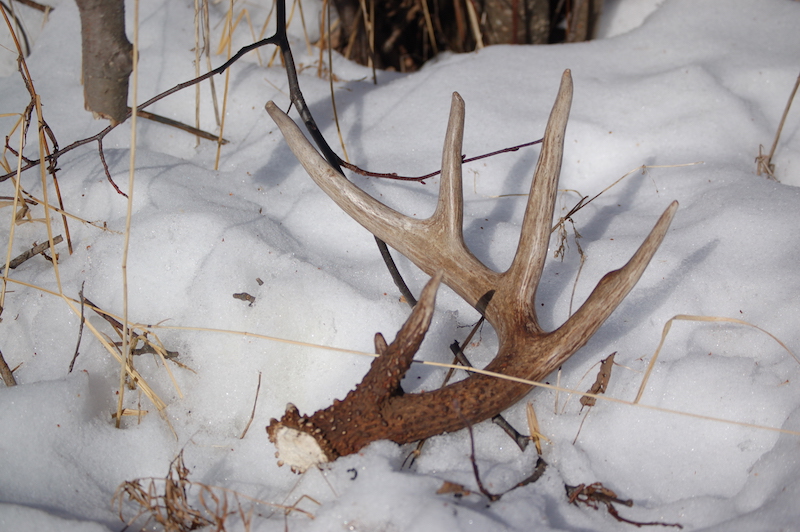Shed-antler hunting has transitioned from obscurity to a mainstream hobby, maybe because anyone can hunt sheds, and a license usually isn’t required.
The ground you hunt could be your own private hunting land, and you might be lucky enough to find sheds from deer you passed up during bow season. You might even find sheds from the buck you’ll arrow this fall. Getting access to hunt sheds on other private lands is usually easier than gaining access to bowhunt. Farmers who have run over antlers know they can puncture expensive tractor tires. They might even invite you onto their fields to pick up antlers.

The shed above was found in an urban greenspace area. Photo Credit: Joe Shead
If you lack access to private land, you can still search millions of acres of public lands for sheds. Although some areas receive shed-hunting pressure, they can still be bountiful places to find antlers. Those lands include state, county and national forests; as well as parks and wildlife management areas. Don’t overlook urban options. Some greenspaces harbor lots of deer, which often cannot be hunted, meaning more bucks live to shed their antlers.
Hunting shed antlers isn’t complicated: You walk areas where bucks spend winter and look for cast antlers. But it’s seldom easy. It’s like looking for the proverbial needle in a haystack. Each buck sports only two antlers, and one place can hold finite numbers of them, so finding even one can be challenging.
Whitetails shed antlers as early as late November and as late as early May in most parts of Canada and the United States, but most shedding occurs from mid-December to mid-March. To find sheds, you must know where bucks live during that period, realizing it might not be the same locations where they spent bow season. By checking trail cameras, watching fields each evening, or wearing out boot leather can help you find winter deer.
With breeding season mostly over, deer spend most of winter and early spring eating and resting. Therefore, you’ll find antlers at food sources, bedding areas, and trails linking those sites.

Look near heavily browsed trees for sheds. Photo credit: Joe Shead
In farm country, you can learn which fields draw deer by driving backcountry roads at dusk. If you can’t be out and about at dusk regularly, cruise around and look for their tracks and trails, which is especially easy when snow is present. Alfalfa and cornfields are good bets, especially if the crop wasn’t harvested. In forest country, food sources are less defined. Deer might find acorns or other mast, or they might be scattered, browsing on dogwood, hazelnut or other brushy plants. Find the food sources, and you’ll likely find antlers.
In cold, windy weather, deer bed where they’re protected from the elements while keeping tabs on predators. They often bed in conifers, which catch snow in their branches, making travel easier. Thick coniferous branches also block wind and hold some heat near the ground. Deer also bed where they’re exposed to the sun, which usually means south-facing hillsides, forest edges, or the south side of lone conifers. A hard edge, such as the southern edge of a pine forest abutting a crop field, makes a dandy bedding and shedding area.
Once you’re in the right area to find sheds, look for anything that looks out of place. Antlers look like sticks, cornstalks and other natural materials, so walk slowly so your eyes can distinguish detail. Walk well-worn trails, but pause to examine potential feeding or bedding sites just off to the sides. In hayfields and chopped corn, use binoculars to identify sheds from a distance. When walking standing corn, slow down and thoroughly cover a few rows at a time.

Don’t give up hope. Continue your search while keeping track of the area you’ve already covered. Photo Credit: Joe Shead
Stay optimistic. It can take days, even years, to find your first shed. It’s not easy, and it takes a while to get a feel for what you’re doing. But after finding a shed or two, you’ll get a feel for it, and start spotting them more easily. My website offers more details on finding antlers than I can cover here.
Almost everyone can hunt shed hunts on public properties, but don’t assume it’s OK. National parks, state parks, forest preserves and some WMAs might forbid collecting natural artifacts, including antlers. In addition, Western states sometimes designate shed-hunting seasons. These seasons keep people out of the backcountry when elk, deer and other game are enduring rough winter conditions. Utah, for example, requires shed hunters to take a course if they go hunting Feb. 1 to April 15. Check with the wildlife agency’s law-enforcement division to confirm if shed hunting is permitted where you want to look. Some restrictions are listed below, but it’s not a full list. Check before you go.
Shed hunting is a great way to learn more about deer, enjoy the outdoors in the offseason, and collect some amazing natural art. Success usually takes a while, but stick with it. You’ll be rewarded.
The Utah Division of Wildlife Resources offers an ethics course shed-hunters must take if they want to collect antlers Feb. 1 to April 15. To hut sheds during that time, participants must carry the certificate for completing the course. You can learn about the course here.
In Colorado, shed hunting is prohibited on public lands west of I-25 from Jan. 1 to April 30. Shed-hunting hours in other places protect Gunnison sage grouse. You can learn more about the rules here.
Wyoming forbids shed hunting on public land west of the Continental Divide from Jan. 1 to April 30. Learn more here.
In Montana, some WMAs are closed to public recreation until noon on May 15 to protect wintering elk and deer. Learn more here.